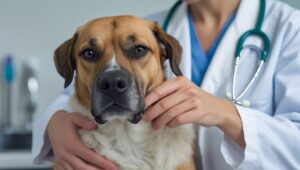Introduction
Sudden dog rashes may be rather scary, and they might also look shocking, especially in case your pet appears irritated or itchy. These rashes are harmless in some cases, whereas they are a predictor of health problems on other occasions. Types of dog rashes are helpful to know so that you are able to take good care of your dog and comfort him.

1. Allergic Dermatitis ( Atopic Dermatitis )
One of the most common skin diseases that affects dogs is allergic dermatitis since the dog is faced with both genetic and environmental allergens, i.e., dust, pollen, or mold.
Symptoms:
- Red itchy spots
- Licking or biting that is excessive
- Hair in the area of trouble goes away
Treatment:
- Antihistamines
- Medicated shampoos
- Allergen control of the environment
2. FAD
Not only do fleas bite, but they also trigger allergies in most dogs. A flea bite may result in serious itching and swelling.
Symptoms:
- Small, good-looking red marks.
- Violent scratching, especially at the backs and at the lower part of the tail.
- Hot spots/scabs
Treatment:
- Anti-flea medications
- Anti-itch medication (medicated cream or oral) treatment
- Frequent grooming
3. Contact Dermatitis
This rash will arise when your dog comes in contact with irritants, such as some grasses, cleaning substances, or sometimes even plastic bowls.
Symptoms:
- Weird swelling or redness on the skin
- Blisters or sores
- Localized itching
Treatment:
- Get rid of the irritant
- With hypoallergenic products
- Use relaxing lotions prescribed by a doctor
4. Yeast Infections
Wet warm areas, such as ears, paws, or skin folds, have high chances of yeast overgrowth.
Symptoms:
- Greasy skin touch
- Musty odor
- Discoloured itchy patches
Treatment:
- Shampoos or creams with antifungal effects.
- Dietary changes
- Folding of wet skin prevention.
5. Infections (Pyoderma)
Commonly, the aftermath of scratching or a pre-existing skin condition, rashes can be brought about by bacterial infections.
Symptoms:
- Pustulose redness
- Warty sores or scabs
- Tenderness or pain on touch
Treatment:
- Topical/oral antibiotics
- Medicated baths
- Curing the cause
6. Acu Castles(Acute Moist Dermatitis)
Hot spots are red, sensitive, and wet sections of the skin, which occur due to excessive licking, and they usually result as a response to the irritation.
Symptoms:
- wet and inflamed red spots.
- Rapid formation and spread of blisters. The development and transmission of a blister are rapid.
- Gross smell of the infected part.
Treatment:
- Cleaning of the area by shaving and hygiene. The area to be cleaned is shaved and cleaned hygienically.
- Anti-inflammatory creams.
- Control of licking behavior to avoid it.
7. Sarcoptic or Demodectic mange
Mange is a very contagious parasitic infection caused by the mites (in sarcoptic mange).
Symptoms:
- Spotty baldness
- Intense itching
- dry, scaly, or crusty skin
Treatment:
- Prescription medications
- Routine scraping of the skin to make a diagnosis.
- Making other pets isolated in case they are contagious.
When do you go to a vet?
When your dog has a rash that takes longer than a couple of days, is growing fast, or appears to hurt, you need to see a doctor. When treatment is delayed, there are chances of infections, or the condition may become worse.

Prevention Tips
- Flea medicine that vets have approved.
- Use non-colloidal allergic or irritant elements.
- Be hygienic and well-dressed.
- Bedrooms ought to be clean and dry.
- Give good food containing skin-building foodstuffs.
What should I do to make my dog comfortable at home when the rash flares once again?
Within the waiting time until a visit to a vet or until the beginning of a treatment process, you may still provide your dog with some help by turning to the following home care options.
In a bid to comfort your dog:
- Oatmeal baths: Oatmeal is natural, and it is soothing; thus, this will alleviate the itchy skin (ensure that the vet approves this).
- Limit biting or scratching: You can restrict licking or scratching by applying an e-collar in case your dog keeps licking the rash.
- Neat beddings and surroundings: The place where your dog rests must be clean and without irritants.
- Hydration: Keep your pet dog hydrated, as this will aid healing of the skin from the inside out.
These will not be a replacement for medical care, but will assist your pet in making its recovery feel more comfortable.
Conclusion
Being aware of the types of dog rashes your pet possesses could be the whole difference in the health and comfort of your pet. In case of minor rashes, when treated well during their early stages, they do not turn out to be a serious skin ailment. It might be some allergy, infection, or parasite; your vet will always know what to do most efficiently.
FAQs
Can I apply human rash creams on a dog?
No, many human creams have conflicting ingredients with the dog creams. Never use non-vet-approved products.
Do dog rashes spread to human beings?
Others are of a type, such as sarcoptic mange or fungal infection, which can be transmitted to humans. Hygiene is a crucial thing.
How will I know that the rash on my dog is severe?
These indicators, such as fast moving, bad odor, pus, or a behavior change, mean a vet job is due.
Are there breeds with just more rashes?
Those that have skin folds (like the Bulldog breed) or also those with long ears (like the Cocker Spaniels) have a higher probability of developing skin problems.
What food can be consumed to avoid dog skin problems?
The health of the skin tends to be improved by fish oils, food rich in omega-3, and hypoallergenic diets.



Pingback: 9 Common Types of Dog Skin Diseases with Pictures
Pingback: 5 Signs of Yeast Dog Ear Infection & Effective Treatments
Pingback: Best 5 Rash Cream for Dogs – Soothe & Heal Dog Skin Irritations